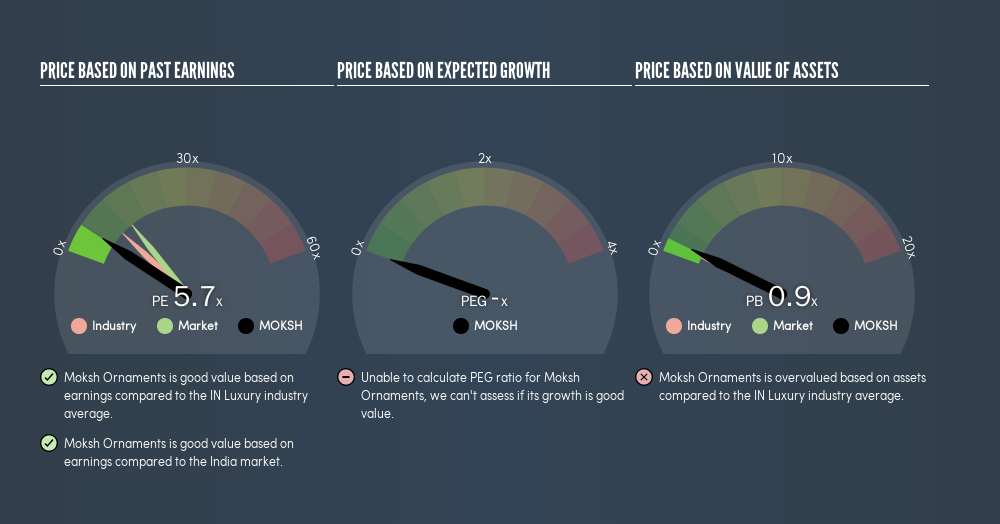A Rising Share Price Has Us Looking Closely At Moksh Ornaments Limited's (NSE:MOKSH) P/E Ratio

Moksh Ornaments (NSE:MOKSH) shares have had a really impressive month, gaining 31%, after some slippage. But shareholders may not all be feeling jubilant, since the share price is still down 11% in the last year.
Assuming no other changes, a sharply higher share price makes a stock less attractive to potential buyers. In the long term, share prices tend to follow earnings per share, but in the short term prices bounce around in response to short term factors (which are not always obvious). So some would prefer to hold off buying when there is a lot of optimism towards a stock. Perhaps the simplest way to get a read on investors' expectations of a business is to look at its Price to Earnings Ratio (PE Ratio). Investors have optimistic expectations of companies with higher P/E ratios, compared to companies with lower P/E ratios.
Check out our latest analysis for Moksh Ornaments
How Does Moksh Ornaments's P/E Ratio Compare To Its Peers?
Moksh Ornaments's P/E of 5.7 indicates relatively low sentiment towards the stock. The image below shows that Moksh Ornaments has a lower P/E than the average (10) P/E for companies in the luxury industry.

This suggests that market participants think Moksh Ornaments will underperform other companies in its industry.
How Growth Rates Impact P/E Ratios
Generally speaking the rate of earnings growth has a profound impact on a company's P/E multiple. When earnings grow, the 'E' increases, over time. That means even if the current P/E is high, it will reduce over time if the share price stays flat. Then, a lower P/E should attract more buyers, pushing the share price up.
Moksh Ornaments shrunk earnings per share by 15% over the last year. But it has grown its earnings per share by 11% per year over the last five years.
A Limitation: P/E Ratios Ignore Debt and Cash In The Bank
One drawback of using a P/E ratio is that it considers market capitalization, but not the balance sheet. That means it doesn't take debt or cash into account. In theory, a company can lower its future P/E ratio by using cash or debt to invest in growth.
Such spending might be good or bad, overall, but the key point here is that you need to look at debt to understand the P/E ratio in context.
How Does Moksh Ornaments's Debt Impact Its P/E Ratio?
Moksh Ornaments's net debt is 97% of its market cap. This is a reasonably significant level of debt -- all else being equal you'd expect a much lower P/E than if it had net cash.
The Bottom Line On Moksh Ornaments's P/E Ratio
Moksh Ornaments's P/E is 5.7 which is below average (13.5) in the IN market. The P/E reflects market pessimism that probably arises from the lack of recent EPS growth, paired with significant leverage. What we know for sure is that investors are becoming rather less uncomfortable about Moksh Ornaments's prospects, since they have pushed its P/E ratio from 4.4 to 5.7 over the last month. For those who like to invest in turnarounds, that might mean it's time to put the stock on a watchlist, or research it. But others might consider the opportunity to have passed.
When the market is wrong about a stock, it gives savvy investors an opportunity. As value investor Benjamin Graham famously said, 'In the short run, the market is a voting machine but in the long run, it is a weighing machine.' We don't have analyst forecasts, but shareholders might want to examine this detailed historical graph of earnings, revenue and cash flow.
Of course you might be able to find a better stock than Moksh Ornaments. So you may wish to see this free collection of other companies that have grown earnings strongly.
We aim to bring you long-term focused research analysis driven by fundamental data. Note that our analysis may not factor in the latest price-sensitive company announcements or qualitative material.
If you spot an error that warrants correction, please contact the editor at editorial-team@simplywallst.com. This article by Simply Wall St is general in nature. It does not constitute a recommendation to buy or sell any stock, and does not take account of your objectives, or your financial situation. Simply Wall St has no position in the stocks mentioned. Thank you for reading.
About NSEI:MOKSH
Very low with weak fundamentals.
Similar Companies
Market Insights
Community Narratives





